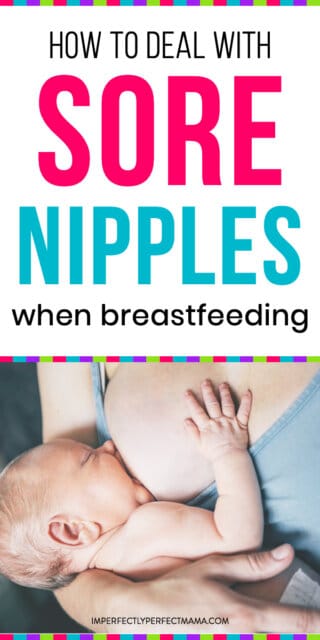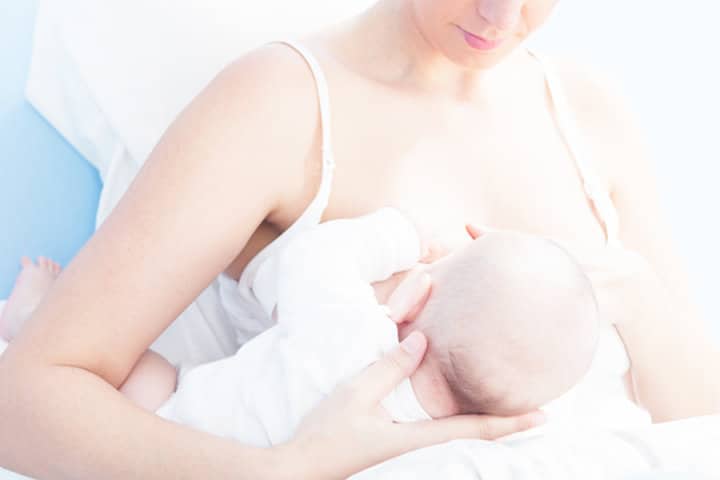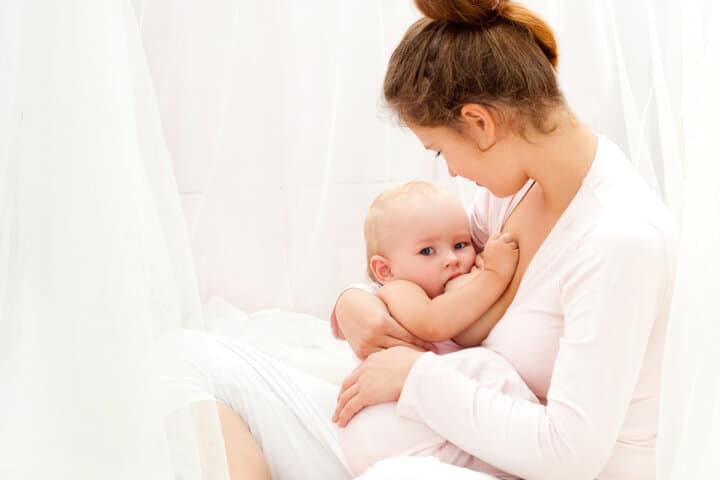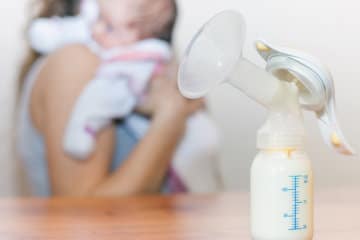You really want to breastfeed your child but the pain of sore nipples is not really encouraging you right now.

You are on the verge of quitting but then there are all these amazing benefits of breastfeeding that you want for your baby.
Does breastfeeding have to be this painful?
How do you deal with nipple soreness when breastfeeding?
I imagine these are some of the questions you are asking yourself.
Seeing that I was in your position not very long ago, I can say it with you that nipple pain and soreness while breastfeeding is the worst.
While breastfeeding should not be painful, a lot of times it can be quite taxing.
Many moms have come to the conclusion that breastfeeding is hard or bad for them and quit on it.
And I can understand their struggle, having endured through the pain of terribly bruised nipples.
But I know that many moms like myself, just want to have a positive breastfeeding experience.
And since nipple soreness is one of the most common breastfeeding problems that new moms experience, learning how to deal with it is key to being successful at breastfeeding.
My Bruised Nipples Story
About 3 days after my second baby was born, I started experiencing nipple soreness and pain during breastfeeding.
But I was determined to keep breastfeeding so I pushed through it.
Bad idea.
It only got worse and my nipples got so bruised that I could not breastfeed without breaking into tears in pain.
Fortunately, I found an amazing lactation consultant who helped me learn what I was doing wrong and gave me the tools I needed to make this journey a success.
I can honestly say that she is the reason I am still breastfeeding my baby girl 7 months later. If it wasn’t for that help, I might have given up by now.
In this post I am sharing the tips that I used to deal with nipple soreness, to heal and start enjoying breastfeeding.
I hope you can use them and start enjoying that bonding time with your little one because breastfeeding should not have to hurt.
How To Care For Bruised/ Sore Nipples

1. Correct the Cause of the Problem
As with all other problems, when experiencing sore nipples the first priority is to get to the root of the problem.
Nipple damage happens as a result of a poor latch.
Latching the baby correctly will involve getting the right positioning which is comfortable for both you and the baby and getting a deep latch.
A deep latch is achieved when the baby’s mouth is covering both the nipple and the areola (darker area around the nipple)
It may take a little practice before you get the perfect latch, but don’t give up.
I would recommend engaging a lactation consultant to help you with latching.
The lactation counselor will show you the step by step process you can follow to ensure that you are getting a deep latch and correct anything you could be doing wrong. Lactation services may actually be covered by your insurance, so make sure to check with them.
If the baby is not latched correctly or it’s painful, break the latch and try again.
Now, this is the part where I wasn’t doing it correctly and ended up hurting my nipples so badly.
To break the latch, insert your clean finger at the corner of the baby’s mouth in between the gums to break the suction before pulling your nipple out. If you just pull it out without breaking the suction first, you will continue to hurt your nipples.
Some remedies for nipple soreness include:
Your Own Breast Milk
For nipple soreness, applying your own breast milk on the nipples can help.
Breast milk has healing properties that can relieve soreness. Which is one of the reasons why breast milk is so awesome and considered to be liquid gold.
I would suggest doing this after every breastfeeding session to keep your nipples moisturized.
Antibiotic Ointments
If your nipples are cracked or badly abraded/wounded, you may need an antibiotic ointment to heal the nipples.
These can be bought over the counter or provided by your doctor or lactation specialist.
When using an antibiotic ointment:
- Rinse your nipples with water after each breastfeeding session.
- Apply a thick layer of the ointment. This will promote what is referred to as moist wound healing which is good for nipple damage.
- Use the ointment after all breastfeeding and pumping sessions
- Discontinue use once your nipples are healed and switch to regular nipple cream
Regular Nipple Cream
Applying a natural nipple cream that is safe for baby to ingest can also offer you some relief.
Nipple creams are good for regular use when nursing. If you can start using them as soon as your baby is born and you start breastfeeding, they can even help you prevent nipple soreness in addition to providing relief.
You should continue using nipple cream until your nipples no longer feel sensitive.
The Earth Mama organics nipple butter is my favorite. I think I used it for about 1 or 2 months and now I only use it only when needed. I haven’t needed it in a while though.
Other good nipple creams are Lansinoh and Motherlove Nipple Cream.
2. Rest Your Nipples by Pumping
When your nipples are too painful to continue breastfeeding, pump to rest them.
If you are in tears each time you put your baby to breastfeed, stop mama. Pump and bottle feed for some sessions to provide relief to your nipples.
I struggled with mom guilt around this because for some reason I felt like I was failing as a mom, but I knew that I needed to take a break when it became too painful.
I stopped breastfeeding for some sessions and pumped instead for 2 days. My husband would bottle feed her during the day as I pumped and I breastfed at night.
Since I had already learned how to latch her properly at this point, that break from breastfeeding gave my nipples a chance to heal, and nursing her was much less painful.
Think of it as a short term break that will allow you to have a successful breastfeeding experience long term. At least that is what it did for me.
3. Vary Nursing Positions
One more tip you can use to relieve nipple soreness is varying nursing positions. There are so many ways you can hold the baby when breastfeeding.
Some of the most common ones are the cradle hold, cross-cradle hold, lying down, and the football hold.
By changing the nursing positions, it varies the position of the baby’s mouth on your breast which can decrease soreness on the same spots.
If you are always nursing with the cradle hold, try lying down or the football hold for a change. You may realize that you don’t feel as sore because your baby’s suckling will not be applying pressure on the same spots as before.
While your nipples are healing, start breastfeeding from the less sore side until letdown occurs and then switch to the other side.
Breastfeeding Does Not Have to Be Painful

Don’t stiffen your nipples, mama. Breastfeeding can actually be enjoyable and without pain.
Relax, practice proper latching, good positioning, and apply all the tips above to promote healing from nipple soreness.
Typically, breastfeeding pain peaks around the 3rd day after the baby is born because that’s when the transitional milk is coming in and your breasts are usually full which makes latching difficult.
If you experience challenges, get in touch with a specialist and let them walk you through the process to make it easier.
Nipple damage due to a bad latch will improve in just a few days after correcting the latching issue.
Just remember that nipple soreness won’t last forever and in a few days, you will be enjoying this journey with your baby.
It’s your turn now, what are your best tips to deal with sore nipples. Share in the comments below.




Leave a Reply